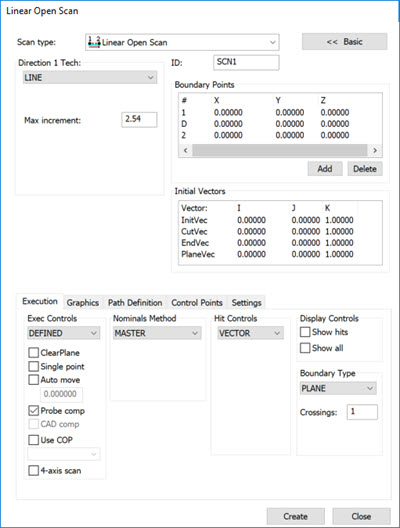
Auto feature scanning strategies and legacy scans have an additional check box called 4-axis scanning.

Circle Auto feature dialog box with 4-axis scanning option for Adaptive Circle Scan

Linear Open Scan dialog box with 4-axis scanning option
This function is available in PC-DMIS Offline mode. If you are online, you must meet these conditions to use this function:
You must use an analog probe or the HP-O laser probe.
You must use an I++ client machine interface connected to Technology Server version 1.5 and a CMM with the Leitz B5 controller.
You must have a rotary table enabled.
The main purpose of this capability is for defined scans. You can use the 4-axis scanning option for Auto feature Circle with scanning measurement strategy in undefined mode (CIR).
To use this option, scan your part or feature in the usual way as with normal scans. When done, select the 4-axis scanning check box. PC-DMIS performs all the necessary calculations and moves.
Be aware you must set the density points setting high so your controller has time to react to changes in the curvature of the scan trajectory. You can also decrease the speed of the scan to help PC-DMIS stay in contact with the part throughout the scan process. This is required for rough surfaces as well as bent surfaces where the scan trajectory contains high curvatures.
The 4-axis scan strategy uses the scan point vectors to calculate the spin of the rotary table. So, after the software generates the scan trajectory, you should check the vectors visually in the CAD view. Verify the scan vectors are correctly oriented, and the changes in the orientation are smooth. Sharp changes could lead to instability in the controller.
When all the feature vectors are almost vertical (vectors are calculated in the plane of the rotary table), the software projects the scan trajectory into this plane. The software uses these new vectors for rotary table angles during scanning.
The purpose of this special case, for example, is when you scan a circle located at the top of a vertically-oriented cylindrical part. In this case, the part spins on the rotary table and the probe stays in one position while performing the scan.
More: